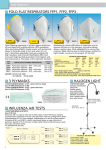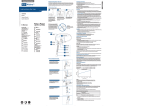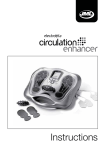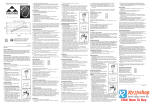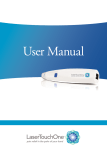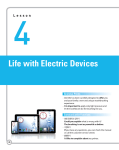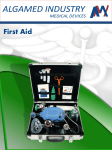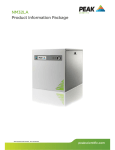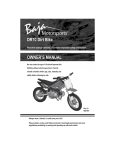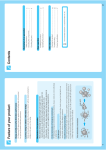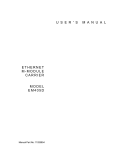Download aveoTSD User Manual
Transcript
® anti-snoring aid User Manual Stop snor ing. S leep b et t er. G et ave o T S D ® . 991 ® User Manual Contents Introducing the aveoTSD® ....................................................................................................1 How aveoTSD Works ...........................................................................................................2 aveoTSD User Instructions...................................................................................................4 Extra Support in Using the aveoTSD ...................................................................................8 Issues, Solutions and Support Chart .................................................................................10 aveoTSD Side Effects.........................................................................................................12 aveoTSD Care and Cleaning ..............................................................................................13 Warranty .............................................................................................................................14 Frequently Asked Questions ..............................................................................................15 Common Causes and Health Consequences of Snoring ..................................................17 aveoTSD Development/History ..........................................................................................19 Introducing the ® Tongue Stabilizing Device The aveoTSD anti-snoring aid was developed after several years of clinical research on the treatment of problem snoring. Unlike traditional mandibular advancement devices, the aveoTSD does not attach to the teeth and does not require fitting by a dentist or dental sleep specialist. ® The aveoTSD is cost-effective and easy to use. For many patients, it will eliminate or greatly reduce problem snoring, making it an effective anti-snoring treatment. 1 Without ® TONGUE In this MRI image, the tongue falls to the back of the throat as a person sleeps. This blocks the airway, leading to snoring. BLOCKED AIRWAY 2 Tongue falls to back of throat during sleep With ® ® This MRI image shows the aveoTSD® holding the tongue gently forward, preventing it from falling back and obstructing the airway. Note how the airway is now open and clear. This stops or greatly reduces snoring. TONGUE OPEN AIRWAY 3 ® User Instructions The aveoTSD® is a medical device used to treat problem snoring. It requires correct fitting so it can be used in the most comfortable manner. Carefully read the following instructions to ensure the best possible results from the aveoTSD anti-snoring aid. Notch 4 The V-notch fits around the lingual frenulum, which holds the tongue to the floor of the mouth. The tongue is free-moving and can easily change size, shape and position. It is unlikely you will damage your tongue with the aveoTSD device. The aveoTSD is available in the U.S. by prescription from a dentist or medical physician. ® User Instructions ® 1. Rinse the aveoTSD under hot water. This helps to ease the device onto the patient’s tongue. Make sure the V-notch is facing down, as shown in the illustration below. Place on the outside of the lips 2. Push tongue gently into the aveoTSD, until it touches the sides of the device. Up Notch 3. Gently squeeze the upper and lower ends of the bulb between the forefinger 5 ® User Instructions and thumb. Note the changes in suction created. By using a gentle repeated pumping action, the tongue will be drawn gently into the device. Make sure the device is not too tight or too loose. This is important: too much suction will cause discomfort; not enough suction will cause the aveoTSD® to fall off during the night. Practice until the device is held firmly and comfortably. 4. keep the aveoTSD on your Initially, tongue for about 10 minutes at a time, adjusting it by increasing or reducing suction to find the most comfortable 6 fit. This will ensure you are not pushing on the lingual frenulum, which holds the tongue to the floor of the mouth. Note: Use of the aveoTSD may initially cause discomfort; however, this will sub- ® User Instructions side. Experiment with the device to find the position and suction pressure most comfortable for you. 5. Suction the aveoTSD® to the tongue in an agreeable position before going to sleep. Initially, it is easier to fit the device while sitting or standing. 6. To remove the device, press in on the sides to break suction. If you prefer, squeeze the bulb with your thumb on the bottom and forefinger on the top. 7. After use, thoroughly clean and rinse the aveoTSD with hot water. Store in the container provided. Do not rinse or store the device in mouthwash or any other chemical product that contains alcohol because this may damage the medical silicone. 7 Extra Support in Using the Some people will be able to use the aveoTSD® comfortably within a couple of days. However, for most patients, it takes one to two weeks for discomfort to disappear. Perseverance with the aveoTSD will be rewarded! As you achieve compliance, it is likely there will be a reduction in sudden awakenings or gasping for air during sleep. This will mean a good night’s rest, giving you more energy through the day and a feeling of improved well-being. The aveoTSD will also provide less distur- 8 ® bance for your partner. However, it is possible because of anatomical features and/ or other health-related problems that some people may have difficulty using this device. If you are unable to use the aveoTSD, or symptoms persist, please contact your primary health care provider or dentist for further consultation. For some people, perseverance and patience is needed, particularly for suction control. This skill will be learned over time. My aveoTSD falls off – Adjust the aveoTSD onto the tongue until the device stays on Extra Support in Using the and you get a good night’s sleep. Salivating – While awake, we swallow frequently. When asleep, we swallow much less. When something is placed between the jaws, salivation is a normal response. Some people may salivate excessively with initial usage of the aveoTSD®, but this side effect will reduce within a week or so of continued use. My tongue has strong sensations – Adjust the aveoTSD by either withdrawing the tongue slightly or reducing the suction a little (see User Instructions). Tilt or twist the device while it has suction OR move the ® aveoTSD slightly forward on the tongue. Tongue-tied users should consult their doctors to check whether minor procedure could free the tongue. This condition is very rare. I have difficulty swallowing and a gagging sensation (along with salivating) – You may have your tongue extended too far. Move the unit back off the tongue slightly, to give the tongue a little more flexibility. Always discuss any problems with your primary health care provider or dentist. 9 ® Issues, Solutions and Support Chart A. Can use, but aveoTSD® comes off during night > Too little suction. Move tongue farther into device to create more suction. Continued usage will reduce “falling off” within a few weeks. B. Can use, but aveoTSD creates sensation on tongue > Too much suction. Reduce suction and move tongue slightly out. Sensation will diminish or disappear as tongue becomes accustomed to the device. C. Have problems fitting aveoTSD under tongue Check on lingual frenulum and tongue-tied status with your doctor. A simple procedure can correct this issue. > Continue using the device. Practice will improve skill. Experienced by less than 20% of users Continue using the device. Practice will improve skill. Experienced by less than 15% of users Do not use the device for three days. Then try again, making sure the device is not irritating the lingual frenulum under the tongue, and that it feels comfortable. If there are also “B” symptoms, stop using the device for three days, then try again. Experienced by less than 15% of users Tongue tie occurs in less than 0.06% of users 10 ® Issues, Solutions and Support Chart D. Increased salivation > Most users will experience this initially because salivating is automatic. After a week or so, the brain recognizes the device is not food and stops salivating. E. Cannot swallow with device in place and saliva builds up Swallowing during sleep happens far less often than when we are awake. With the device in the mouth, saliva builds up. If the tongue is too stretched it is less flexible, so swallowing will be more difficult. F. Physical changes to aveoTSD > This is linked to “B” on the previous page. Reduce suction pressure on tongue by gently squeezing the aveoTSD and moving tongue slightly out of the device. Experienced by 80-95% of users Ease aveoTSD® off tongue slightly so that some flexibility returns to the tongue. When salivation reduces, so will the gagging feeling. Experienced by less than 5% of users > If the device smells, it may not be properly cleaned, or a dental check may be needed. If device looks different, ensure you are not using mouthwash or an alcohol-based cleaning agent, which can damage the device. G. Tongue has changed color Persevere. Some people create more saliva than others. > Refer to Care and Cleaning. Experienced by less than 0.01% of users Others have also experienced this. It is important to realize that in most cases, these symptoms are caused by the use of medication for treatment of high blood pressure or cholesterol. Experienced by less than 0.01% of users 11 ® Side Effects No moderate or serious side effects have been reported. Reported side effects are temporary and occur only during initial practice and use. Refer to Issues, Solutions and Support Chart if you have difficulty with initial usage. During initial usage, should discomfort or other perceived side effects occur, stop using the aveoTSD until the cause is established. Seek medical attention or review practice steps to correctly fit the device. 12 ® Care and Cleaning Keep the aveoTSD® clean by rinsing it daily in hot water. Do not use mouthwash to clean or store the device because alcohol will damage the medical silicone used to manufacture the aveoTSD. Once a week, give your aveoTSD a thorough wash, then rinse. Use denture cleaning solution to give it a weekly or monthly wash for long-term use. To release seal of container: The aveoTSD can be sterilized with cold sterilant or clinical procedures such as autoclave. Squeeze sides Ease apart Remove device 13 Warranty Innovative Health Technologies (New Zealand) Ltd. will provide a six-month replacement warranty from the date of purchase for product defects determined to be caused by the manufacturer. Hong Kong, Japan, New Zealand, USA and other countries. Patents have been granted in those countries. The aveoTSD® is a medical device used to treat problem snoring. (See Frequently Asked Questions on p. 17 for more information.) The aveoTSD can be prescribed to patients via a dentist or medical physician, who can also advise on problem snoring and its potentially serious health consequences. This advice may also include a visual anatomical check to ensure the device fits properly. The device is clinically proven and has regulatory approvals to be marketed as a Class 1 medical device in Australia, Canada EEC, Users of the aveoTSD need one to three days, occasionally more than two weeks, to achieve compliance. 14 Warranty Practice and perseverance is needed for all medical devices. Some people are able to adapt to their use quickly; others require more practice and sometimes professional or medical assistance. Innovative Health Technologies (New Zealand) Ltd. cannot therefore warranty compliance usage issues. Usage is a personal matter in ensuring the device works properly. Innovative Health Technologies (New Zealand) Ltd. has an ongoing post-development support program to improve the product. The program also aims to improve correct usage (compliance) through instructions to health professionals and users. Further user support will be obtained from professional and user feedback as product usage widens. The aveoTSD® product life has not yet been established, but 12 months use should be a minimum, provided proper care is given to the device. Users should follow instructions in this booklet and are advised to seek early advice and/or treatment if problems arise. 15 Frequently Asked Questions What causes snoring? Snoring is caused by a narrowed airway during sleep. This can be due to large tonsils or a long soft palate or uvula. Overweight people who have excessive flabby tissue in the throat also experience snoring. All of these areas relax during sleep. In other cases, nasal congestion from allergies or deformities of the cartilage between the two sides of the nose can contribute to narrowing of the airway. However, the most common cause of a narrowed airway is a tongue muscle that becomes too relaxed during sleep and gets sucked back into the throat with each breath taken (refer to MRI images). Snoring occurs because air travels faster through a narrow tube than through a broad one. This rapidly moving air causes the relaxed soft tissues of the throat (tonsils, soft palate, uvula or excessive flabby tissue) to vibrate. It is this vibration that creates the sound of snoring. By keeping the airway open, air travels more slowly, reducing throat vibrations and thus reduc- 16 ing or stopping snoring. One of the most effective ways of keeping the airway open during sleep is by holding the tongue forward. Is snoring harmful? New research suggests that problem snoring can cause hypertension and, as a result, increased blood pressure during sleep. This airway obstruction causes the heart rate to fall below normal, with decreases in blood oxygen levels. The obstruction will not clear until the brain’s oxygen level falls low enough to partly wake the sleeper with a release of adrenaline. This is an automatic body reaction intended to prevent suffocation. The airway obstruction is usually broken with one or several often loud gasps to take in fresh air. Due to the adrenaline release, the heart rate is increased above normal. This event may happen hundreds of times a night for someone suffering from problem snoring, which means the sleeper does not get a deep, restorative sleep. Most common causes of snoring r"UPOHVFUIBUCFDPNFTUPPSFMBYFEEVSJOHTMFFQ r-BSHFUPOTJMTMPOHTPGUQBMBUFPSVWVMB r#FJOHPWFSXFJHIU"SFDFOUTUVEZTIPXFEUIBUBQFScent weight gain may lead to a six-fold increase in the likelihood of developing habitual problem snoring Snoring has been linked to an increased risk of: r)JHICMPPEQSFTTVSF r$BSEJPWBTDVMBSEJTPSEFST r%FQSFTTJPO r/BTBMDPOHFTUJPOGSPNDPMETBMMFSHJFTPSEFGPSNJUJFTPG cartilage in the nose r*NQPUFODF r4NPLJOH BMDPIPM PS NFEJDBUJPO XIJDI DBVTFT ESPXTJness) r3FáVYBOEIFBSUCVSO r)ZQPUIZSPJEJTN%VFUPBMBDLPGUIZSPJEIPSNPOFTTVGferers tend to have a large tongue as well as increased fat deposits in the tissue of the upper airway r0CFTJUZ r%JBCFUFT r.FOPQBVTF 1PTUNFOPQBVTBM XPNFO XFSF TIPXO UP have more than twice the risk of problem snoring r4USPLFT r.FNPSZQSPCMFNT 17 How many people suffer from problem snoring? More than 60 percent of the adult population suffers from problem snoring, particularly those aged 50 and older. As people age, the tissue in the upper airway loses its elasticity and tends to vibrate more during breathing, increasing the incidence of snoring. When the airway is reduced during sleep, the tongue is more easily sucked into the back of the throat and obstructs the airway. At least 60 percent of men and 40 percent of women over the age of 40 snore. Snoring is also quite common in children between the age of 2 and 7, particularly if they have a chest infection or enlarged tonsils. Snoring is also commonly experienced by women during the latter stages of pregnancy. 18 ® Development/History We spend one-third of our lives asleep, and the quality of that sleep has a real impact on our quality of life. Problem snoring can be treated, but until now, a treatment that is simple to use, noninvasive and cost-effective was not available. The aveoTSD® was developed over several years, with the last few years being spent developing the current model designed by Dr. Chris Robertson of New Zealand. Dr. Robertson is an internationally recognized researcher in the field of Dental Sleep Medicine. “Aveo” is Latin for “be well.” Quality of sleep and sleep medicine are relatively new areas within health care, with a growing awareness of the serious health consequences of problem snoring. It is now recognized that snoring is a health warning, and the ability to diagnose and treat sleep-related problems associated with snoring means many people now have a greatly enhanced quality of life. 19 20 ® Australia aveotsd.com.au New Zealand aveotsd.co.nz Austria aveosleep.eu Qatar innomed-intl.com anti-snoring aid is a registered trademark of Innovative Health Technologies (NZ) Limited Australian Patent No. AU776822 Canadian Patent No. CA2432023 Canada aveosleep.ca Switzerland aveosleep.eu Germany aveosleep.eu The Netherlands stoppenmetsnurken.nl Ireland tlcperformance.org United Kingdom aveosleep.co.uk Japan aveotsd.com United States getaveo.com European Patent No. EPI349521 Japanese Patent No. JP544615/2001 Hong Kong Patent No. HK1060041 New Zealand Patent No. NZ526404 United States of America Patent No. US7073506 International Patents (Pending) Innovative Health Technologies (NZ) Limited aveotsd.com [email protected] Registered Office: HGW Health Board House, 229 Moray Place, Dunedin, New Zealand. PO Box 17572, Christchurch, New Zealand. Copyright © 2010 Innovative Health Technologies (NZ) Limited. ® anti-snoring aid A clinically proven medical device for the treatment of problem snoring Contents: 1 Device 1 Storage Container 1 User Manual 994 GL-2281-0810 Glidewell Laboratories 4141 MacArthur Blvd. Newport Beach, CA 92660 800-334-1979 getaveo.com The aveoTSD® is made from soft medicalgrade silicone and works by holding the tongue forward using gentle suction, preventing it from falling back into the throat and blocking the airway during sleep. 9421900067015

























